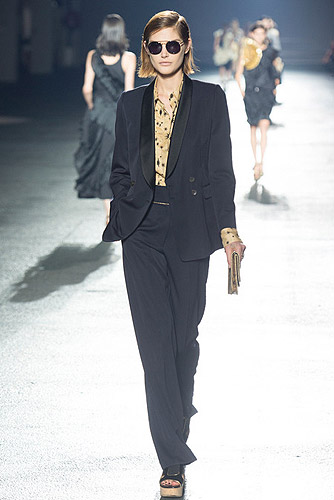


















































The designer teased the face-off between the peasant authenticity of raw cotton and the outrageous flounce of gold lamé ruffles by sticking them in the same outfit.
www.driesvannoten.beParisFashion WeekFashion Brand
The designer teased the face-off between the peasant authenticity of raw cotton and the outrageous flounce of gold lamé ruffles by sticking them in the same outfit.
Anyone who was at Dries Van Noten's men's show in June was prepped for his women's presentation today. Back then, he was talking about how his research for his career retrospective at the Musée des Arts Décoratifs in Paris next February had led him to the "pretty, but strange" flower prints that men wore over the centuries. He was thinking about men like Oscar Wilde, Jean Cocteau, Jimi Hendrix. For his new collection, you could almost imagine the women Dries had on his mind as their decadent soul mates—extravagant free spirits like Tamara de Lempicka and Loulou de la Falaise. Spring be damned, the show was a stunning parade of dark tulip damasks, jet black ruffles, Byzantine gold, Ottoman tassels, and embroideries that set the night sky against barbed wire as the season's leitmotif. Into that heady brew Van Noten stirred the plain and simple, in the form of honest, hardy fabrics like poplin, calico, natural linen…the result was a perverse, audacious marriage of rich and poor. Opulence masked itself: A gold leather waistcoat gleamed under a rough calico coat; a crocodile handbag was burrowed deep inside a carpetbag. It was just like the royal family (French, Russian, pick another) disguising themselves as peasants in a futile attempt to escape the revolution. And there's a cautionary tale for our time.
The detail was extraordinary. There were tiny droplets of gold in the models' eyelashes and gold woven through the parts in their hair. The backdrop of the men's show was massive sheets of quivering gold Mylar. Here, the gold was applied as foil to huge slatted wood screens. The empire was failing, the gold was flaking, but still, the artisans slaved on. The handwork on a micro-beaded gold shift was so miniscule it was almost invisible. An equally minute tracery of sequins paneled the front of a calico coat. (It's moments like these when Van Noten effortlessly touches on the obsessiveness of haute couture.)
The designer teased the face-off between the peasant authenticity of raw cotton and the outrageous flounce of gold lamé ruffles by sticking them in the same outfit. He joked that his last look—anchored by a giant rosette of white and gold—was "bridal," but seconds before, he'd shown the same outfit in a furious flounce of funereal black, complemented by Daiane Conterato's resolute little face looking like she was ready to flamenco that frock to death. Dries conceded the darkness of the collection, the almost gothic quality. But he insisted that Spain, inspiration for the ruffles, was dark too: Goya, Velázquez, Zurbarán, Balenciaga…
The soundtrack was a solo performance by the bass guitarist Colin Greenwood, of Radiohead. Inspired by his favorite piece from the collection, which featured a cunning use of the barbed wire embroidery, he adapted the bass line from the Radiohead song "My Iron Lung." For his Spring men's show, Cindy Blackman Santana's drumming; for his women's, Colin Greenwood's bass. Next season? "Well, obviously, Cindy and me playing together," said Dries. Wait for it: Dries Van Noten, über lord of fashion's drum 'n' bass set.